I.
COMEL IS THE daughter of a mamasan, a woman who runs one of several local brothels. Sometimes, in the afternoons, when her husband is out, Comel also turns the occasional trick, but otherwise she’s like any other twenty-one year old in the area, lively, chatty, obsessed by her smartphone. She is a sex worker who is not really a sex worker, hovering between two worlds.
Both mother and daughter are married to Indonesians, one a sailor, the other a migrant worker. At the end of the month, on pay day, they can see the dock workers queuing up at the ATM on the other side of the highway, waiting to draw out enough money to spend the evening with a girl. Here in the northern stretch of Port Klang, Malaysia’s busiest port, nightlife is sparse, and what there is feels gritty and distinctly unglamorous, a different world from the sophisticated Western-style bars and restaurants of the capital, Kuala Lumpur, only an hour’s drive away. The country’s gateway to the sea, Port Klang and the surrounding coastline seem to be disconnected from the rest of Selangor, the richest and most populous state in Malaysia, as if all the trade and industry that flows through its docks has decided to settle elsewhere, bypassing the coastline altogether.
The women live in an area of dilapidated shop houses hemmed in by a massive new elevated highway that separates them from the rest of North Port. This new road casts a shadow on the area where Comel and her friends live, the houses becoming shabbier with each passing year. Over time, some have collapsed entirely, leaving ghostly spaces in the rows of once-fine shophouses; others now have ficus trees sprouting from their masonry, their roots further destroying the fabric of these buildings. As for the fabric of the lives that occupy this area, there is a sense, too, that they are caught in a sort of stasis, cut off from the hubris of economic development elsewhere in the port, and indeed in the steadily modernizing country beyond. Yet Comel and her friends live with a sort of optimism that belongs to the narrative of “1Malaysia,” the government’s campaign to promote national togetherness and industry: they are part of the idea of a progressive, can-do country riding the swell of the material transformations taking place in Asia in the 21st century. Like so much else in photographer Ian Teh’s work, she occupies that space in between two worlds, two conflicting realities. She both is and isn’t what she appears to be, nor – crucially – what she wants to be.

Ian Teh, A First Generation Migrant from Indonesia Married to a Local, Port Klang. All images courtesy of the photographer.
Abstract beauty collides with the hard-edged reality of contemporary Asia in Ian Teh’s photographs, producing an effect that is at once mesmerizing and disconcerting. If his subject is the world of the unseen – the people and landscapes that are everywhere, but strikingly unnoticed – then his images, too, draw the viewer into that nebulous space between admiration and revulsion, though there is barely a difference between them. In his universe, the two are linked; so, too, the wondrous and the banal, the magical and the horribly real. Sometimes it is difficult even to know what you are looking at. Every time you venture into one emotional space, his work calls you back into another.
He and I first met in London in 2011, when he was taking my portrait for an Olympics photography exhibition the following year. London-based photographers had been asked to photograph someone from their country of origin, and, through a series of chance connections involving mutual friends from Beijing, we met and Ian asked me to sit for a portrait. Much later, when we’d already become friends, we joked about how people from similar backgrounds have a habit of making connections with each other thousands of miles from home, but that first day, it seemed entirely natural that we should meet; our crossing paths didn’t feel coincidental. We were born in the same year and moved to Britain in our teens – he at thirteen, with his mother, I five years later to attend university; we grew up in ethnic-Chinese families in Malaysia, the first of the new middle-class, neither rich nor poor, one generation away from poverty, yet brought up to believe in the possibilities of education and employment in a rapidly-industrializing country. Our families remained largely in Malaysia, leaving us anchored in two vastly different countries and cultures – a cultural background that shaped our shared view of the world.
Throughout the three sittings for the portrait, we talked about how growing up as ethnic-Chinese in a Muslim-majority country meant being constantly aware of our immigrant roots, of having some distant connection with peoples and cultures seemingly far removed from our home. We were insiders who were also, in a small but profound sense, outsiders. And, by choosing to live in Britain, we have, in a way, turned ourselves into double immigrants. Perhaps this is why in my novels and his photography we’re both preoccupied with outsiders – not just people who are marginalized by poverty or discrimination or lack of opportunity, but those who struggle to find their place in the world; people who, like Comel, fall into the cracks between the neatly-defined categories that life lays down for us.
Take his large-format landscapes Traces. When series was shown at the Flowers East Gallery in Shoreditch, London, I first saw ravishing images of snowy landscapes in the industrial heartland of northern China. Shimmering white peaks gracefully scarred by meandering rivers; frosted poplars standing against fields of snow. Once the initial frisson of beauty wore off, though, I realized they’re not mountains of earth and stone, but giant piles of industrial waste; the rivers not torrents of melted snow, but streams of slag, run-off from the steel and other factories nearby; toxic waste shines whiter than snow, and pollution, not frost, settles on the trees. The eye takes in one thing, the intellect another. Yet Ian is not making a judgement here. There are no tiny clues that push you to appreciate the images as Beautiful Art or social commentary. Beauty is deceptive, the photographs say, but by indulging in it, are we also somehow tacitly participating in the destruction of our landscape? Or, conversely, having destroyed what we have? Do we now contemplate that loss and see a strange, haunting beauty?
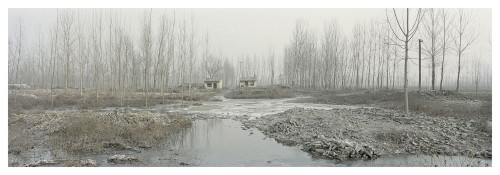
Ian Teh, Farmland. Linfen, Shanxi, China from the series Traces.
When I left the gallery that day I was confused by the way the photographs had restructured my notions of beauty. The humanity of Ian’s work, I remember thinking, lies in its openness, its ability to share the wondrous and terrifying possibilities of the way Asia is developing.
In Confluence, his sweeping yet sometimes chokingly personal portrait of Comel’s Selangor coastline, he allies powerful social commentary with details that can seem, to me, suffused with melancholy. In an exhibition that opened last week in Kuala Lumpur’s Publika, objects and beings usually overlooked take center stage. A herd of cows stare mournfully at the camera; a sow rears out of its pen on a pig farm; a hand-scrawled notice in bad Malay exhorts people not to litter or play loud music; a kitsch framed picture of a bucolic European landscape hangs marooned on a bare wall’s flaking plaster. People come and go in these images, flitting in and out of the frame, almost as if they don’t want to be there. Their expressions are distant, distracted: they are elsewhere, their thoughts occupying a different terrain.
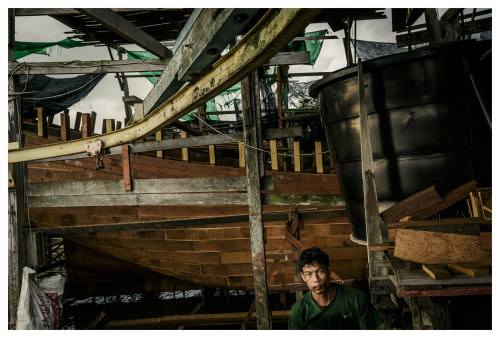
Ian Teh, A Burmese Laborer at a Traditional Wooden Boat Builder’s Yard, Sekinchan.
Malaysia is a country built on migration – from the descendents of Arab sea traders who first arrived in the twelfth century, to the waves of indentured laborers from India and China in the nineteenth century, to the historic links with Sumatra and Java. Malaysia’s culture is inextricably tied to the evolving histories of its neighbors, tied to a narrative of journeys. So it’s unsurprising that much of Confluence focuses on the migrant workers who are a growing part of daily life in most parts of the country, and who are particularly pronounced along this stretch of the west coast – recent immigrants from Indonesia, Bangladesh and Burma, who reflect Malaysia’s economic rise over the last thirty years, and its relative wealth in South East Asia. The unattached, almost absent nature of many of the subjects’ gazes suggests a sense of dislocation, their presence immediately raising questions of belonging. Are they comfortable in their new surroundings? How do they see themselves – as temporary economic workers or as part of a new wave of immigrants? How is society stratifying into rich and poor in contemporary South East Asia? What is the gap between the privileged and the forgotten?
Workers stand in the midst of plantations, or while away time at the harbour as night falls. They have jobs, they are sending money home, they are working. But in Ian’s images their expressions are tentative, caught between aggression and fear, neither defeated nor optimistic. And their stares become a statement of presence that invites us to enter their world.
His work has long had a sense of loss, but while the threat of a world on the brink of change looms large in Traces, here the feeling is more intimate, and more personal to Ian and me. A sequence of images charting a funeral recounts a real, physical passing, but even the living seem to have let go of something essential to their beings. Where, for example, are the wives, children, parents of these migrant workers? What have they given up to be here? And what of the physical structures, those magnificent old Chinese stuccoed shophouses, half-destroyed and on the brink of total collapse? Elsewhere, perfunctory modern apartment blocks stand ghostly and empty, as they often do in his portraits of contemporary Asian housing, as if they have given up the right to host life – as if they are all too aware of the passing on of things here in modern Malaysia. It’s this giving up of something precious, the passing on of things – either voluntarily or forced by time or other circumstances – that I find moving, even troubling. Perhaps it’s because of my own background, because of the anxiety that invariably accompanies moving from one culture to another, and that never really disappears. Perhaps it’s because the study of migrant workers and others who have yet to nail down their positions in the world reminds me of what my ancestors must have been given up in order to start a new life.
II.
One of the occasional treats I had as a child was a drive out to Carey Island for a Sunday lunch of chilli crab in one of the many famous seafood restaurants that dotted the coastline south of Port Klang, the area that forms the subject of Confluence. The family would pile into our Ford Cortina and meander along roads that traced the broad sweeps of the muddy rivers that cut through Selangor and converge at this stretch of the coast, emptying into the Straits of Malacca. We’d cross little bridges over brackish inlets that smelled of rotting vegetation and brine. The restaurants were wooden shacks built on stilts over these inlets, and we would toss the empty crab shells over the sides of the wooden banisters into the water after picking the flesh from them. At low tide the waters would retreat to expose rusty oil drums and old boats mired in the mud; occasionally the waiters would empty entire dishes of crab shells and other food scraps to be carried away on high tide. Of those days I remember a glorious feeling of disorientedness – we were far enough away from the bustle of Petaling Jaya, the largest suburb in Selangor, where we lived, to feel that we were in the countryside, but not far enough to feel properly in the wilderness. Container ships dotted the horizon on their way to and from Port Klang; we could never tell if they were even moving.
I am connected to the landscape that Ian Teh portrays in Confluence by delicate threads of memory, but what draws me to it as an adult is a recognition of its foreignness – the way it is always present in the consciousness of Selangor dwellers yet rarely visited by them. We live a mere twenty or thirty miles from the coast, yet would much more readily drive the five hours to Penang, half the length of the west coast, just for the weekend. It is a place of trade and movement, of the meeting of land and sea, of freshwater and saltwater, a fluid melange of cultures, yet it remains invisible to the affluent suburbs elsewhere in Selangor, home to the most affluent suburbs in the country.
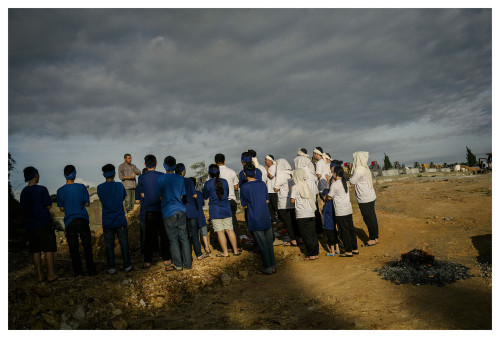
Ian Teh, A Chinese Funeral, Sungai Pelek.
Looking at Ian’s images of the funeral, I remember my grandfather’s similarly elaborate Chinese funeral in Perak. I remember the burning sun, the rituals, the sadness laced with boredom and fatigue, the long period of mourning afterwards. Above all, I remember the same bewilderment that I see on the faces of the mourners here. The funeral is a pig farmer’s. We don’t know what’s going to happen to the farm, whether the children will take over or whether it will slip into ruin. Suddenly the pig that rears from its pen takes on a new anxiety. I remember staring at the empty chicken coop in the back of my grandfather’s house in the days after his funeral. The chickens he reared for food became pets, well-fed hens that clucked and shat in a space under the air well close to the shophouse. When he died, the chickens were slaughtered to feed the dozens of friends and relatives who came to mourn. I knew they’d never be replaced.
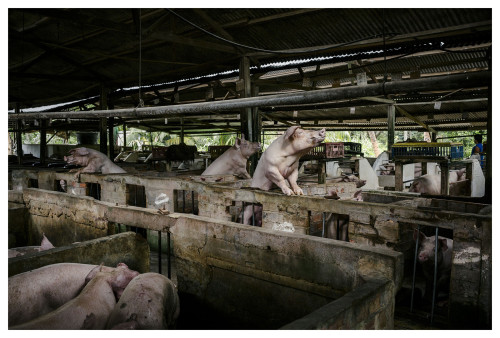
Ian Teh, A Pig Farm, Kuala Langat.
Everywhere in Ian Teh’s photographs I feel the vulnerability that permeates Roland Barthes’ strange yet seminal little book on photography, Camera Lucida, and I understand, finally, all its statements that previously I found infuriatingly subjective. In order to see a photograph well, you need to look away. It seems clear to me now that what Barthes meant was that you have to delve into memory in order to understand what lies before you, but that the act of recalling risks casting doubt on the certainty of the image you are beholding. We can subject a photograph to any amount of objective artspeak we like, but ultimately we bring our own subjective understanding to each image. Barthes went in search of images of his dead mother, but none represented the person he knew or loved. In those photos he recognized his mother objectively, but couldn’t feel her. She was familiar yet unknown. Ultimately he did find an image that represented her truly, as he remembered her. She was five years old in that picture, standing in a winter garden in 1898, a place and time he had never known. Suddenly: an onrush of memories. He cries. And then every photograph for him becomes a morbid memorial, an anticipation of “total, undialectical death,“ including his own.
I don’t discern the shadow of death in Ian Teh’s photographs, but rather a constant anticipation of the passing of things; and in this way his work throws light on the original title of Barthes’ book: La Chambre Claire – the bright, light-filled room, the opposite of la chambre noire, the darkroom. Our real understanding of photographs lies away from the negatives and the printing and the labs, away from the objectivity that the camera lens and digital technology provide us; it lies in a space that we appreciate instinctively, a space that is tied to memory, to our own anxieties and aspirations. The best photography leads us to such spaces of illumination and lets us grapple with our vulnerabilities. The best photography is beyond beauty, even beyond meaning.
III.
In four night scenes that revolve around the gritty reality of Comel’s world, the derelict buildings and brothels are presented as a dreamscape, populated by people who don’t seem quite attached to that land, who live a floating life despite the coarse demands of their every day lives. Lit by eerie phantom colors, these photographs often seem more nightmarish than dreamy. Ultraviolet blue contrasted with glowing, hellish orange; overbright yellow, so luminous it seems to have been artificially cast by stage lights; tentative fluorescent lighting: there is all the shimmering terror of a nightmare in these photographs, where the people seem otherworldly, the physical structures illusory, leaving us uncertain of where we stand.
The empty space between two old stone shophouses suggests that a third was pulled down at some time in the past. Rubble on one side of the hollowed-out gap stretches into darkness. Objects lurk in the shadows – we can just about discern the outlines of a shed? The glint of an enormous blade? In the foreground, a transgender sex worker sits on a pile of rocks, waiting for clients. We can’t see her features clearly but from a distance her face appears powdery white. With an eerie beauty, the photograph crystallizes our unconscious fears. It’s a vision of what we think might happen when all life has departed, and what’s left is consumed by forces more primeval and powerful and threatening than those which fill our domestic lives. It can’t be real; it’s something from our imagination and yet it is real. It exists a mere twenty miles from our pleasant suburbs.
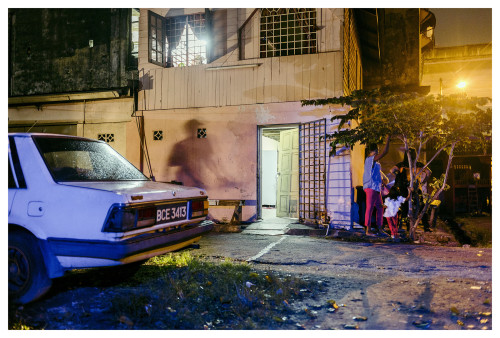
Ian Teh, Shadow of a Potential Client, Port Klang
A cheap, ancient Datsun stands outside a banal two-story house – both so innocuous they barely merit a second look, and the building hardly suggests a whorehouse. The rooms are lit by the cheap, blinding fluorescent tubes, but one room upstairs lies ominously dark. Who is in it? Yet outside, under a small tree, a woman and small child play in the balmy evening the way parents play with their children all over the world. We don’t know which reality this scene belongs to. The image suggests “underworld” but it’s also a commonplace neighborhood scene in this part of Malaysia. The shadow that looms ominously is a man, we think, but is he coming or going? Is he a father or a client, or perhaps both? In order to understand the photograph, we have to look elsewhere. We have to look at that man.
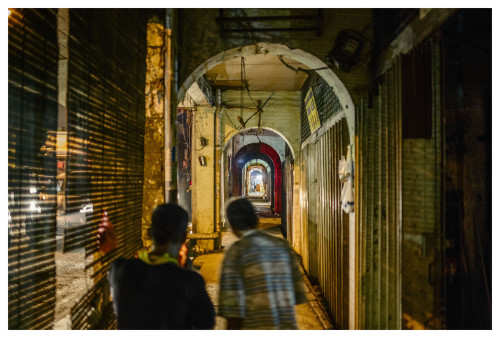
Ian Teh, A Man Lights Up a Cigarette in an Alleyway, Port Klang.
So, too, the two men hurrying down the arched walkway in front of the row of shophouses. On their left are lowered bamboo blinds; ahead of them at the end of their tunnel is fluorescent light. What are they hurrying to when it’s so late that everything else is shut? A food stall for supper? The scene is familiar – two friends out for the evening – but a suggestion of danger lurks as if some act is about to be committed, or maybe just was. The men’s walk is urgent; their shoulders incline forward, pushing towards the light. Nothing is in focus. The blurriness makes us anxious, even as our eye recognizes the interplay of shadow and light as beautiful. It is with this tension that we see Comel, too. She’s pretty, her clothes and make-up are colorful, she’s just checking the messages on her phone. But we don’t know where she is, don’t know what she will be doing after she finishes writing messages. We don’t know if she will be safe.
IV.
A few weeks ago, I drove out to the Selangor coastline, to Port Klang and beyond. I wanted to see the cheap seafood joints and goat farms I remembered from my childhood, not out of any pronounced sense of nostalgia, but just to see how things had changed in the twenty-odd years since I’d last been there. There were more palm oil plantations than before, though I couldn’t be sure. The people working on there seemed now to be almost entirely drawn from migrant workers, and they seemed to have more tools, their uniforms indicating a greater degree of organization and industry than the casual labor of two decades ago. I didn’t recognize any landmarks, and couldn’t in the end, find the crab shacks my parents had taken me to. They probably don’t exist anymore. But these changes didn’t alter the nature of the landscape – small wooden boats lay marooned on the mud flats of the rivers when the tide was out, as they did before; derelict-looking shacks full of pieces of scrap stood under the broad spread of acacia trees; coffee shops that hadn’t been renovated for years continued to draw in a few customers; the small towns I drove through seemed busy and – as always – on the verge of shutdown.
I stopped for iced coffee in a place by the side of the road, a shack not unlike the one in Ian’s series of photographs. On one side of it lay a tire repair shop, on the other a muddy parking lot half-filled with stacks of concrete slabs. I overheard a conversation in Cantonese – two men in their thirties talking about jobs and girls. They wanted to work in Kuala Lumpur, and then maybe Hong Kong, or China – China was where the action was these days. One of them had had a fling with a girl from Shenzhen, China, but he thought maybe she was a hooker. He was wearing a t-shirt that said “Texas Country” above a drawing of a racing car.
In my mind’s eye, I always saw the Selangor coastline as somewhere fixed, unchanging, but it was never so. I had just been too young to see that the sea brought with it not just goods but people, and that made it easy for people to leave, too. In my imagination this was somewhere that would never change – the buildings would always be run-down, the towns would never acquire the gloss of Kuala Lumpur, the people would forever be dockworkers and farmers. It was unchanging in its foreignness, its difference from me. Yet in its conception and its evolution, it represents exactly the arc of Malaysian society. It tells, starkly, the tale of migration, both of arrival and departure, and of carving out a place in the world. In the flimsy roadside restaurants and old timber village houses I saw how the buildings anticipate the passing of things, but also how the temporary has a strange habit of becoming permanent.
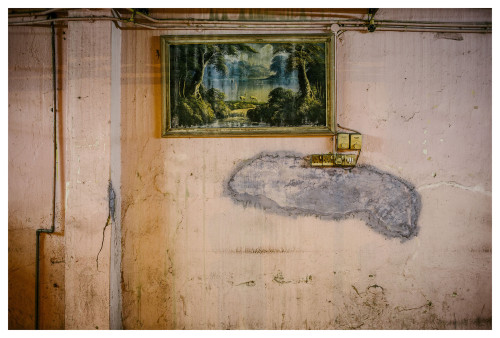
Ian Teh, A Painting Outside a Partially Abandoned Building, Port Klang.



Pingback: Malaisie, literature, Tash Aw -You Need To Look Away: Visions Of Contemporary Malaysia | The Weeklings | Asean Weaver For Business Blog
I think I need to check out your site more reguraley. Very nice